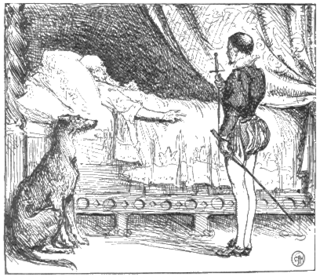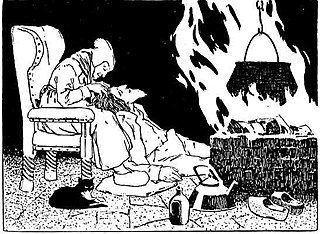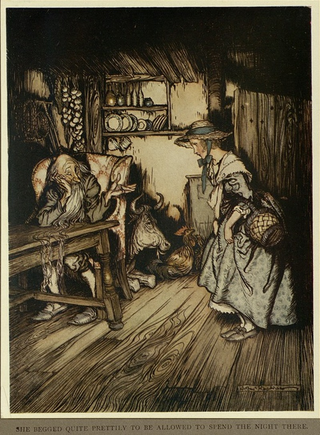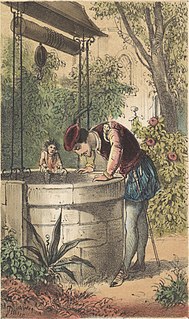Related Research Articles
The Canary Prince is an Italian fairy tale, the 18th tale in Italian Folktales by Italo Calvino. He took the tale from Turin, making various stylistic changes; he noted it developed a medieval motif, but such tales as Marie de France's Yonec produced a rather different effect, being tales of adultery. A variant on Rapunzel, Aarne–Thompson type 310, The Maiden in the Tower, it includes many motifs that differentiate it from that tale. Other fairy tales of this type include Anthousa, Xanthousa, Chrisomalousa, Petrosinella, Prunella, and Rapunzel.
The Red Ettin or The Red Etin is a fairy tale collected by Joseph Jacobs. It was included by Andrew Lang in The Blue Fairy Book.

"Trusty John", "Faithful John", "Faithful Johannes", or "John the True" is a German fairy tale collected by the Brothers Grimm and published in Grimm's Fairy Tales in 1819. Andrew Lang included it in The Blue Fairy Book.
"Thirteenth" is an Italian fairy tale originally collected by Sicilian folklorist Giuseppe Pitrè and published by Thomas Frederick Crane in Italian Popular Tales. It is Aarne-Thompson type 328, "The Boy Steals the Giant's Treasures".

"The Devil with the Three Golden Hairs" is a German fairy tale collected by the Brothers Grimm. It falls under Aarne–Thompson classification types 461, and 930.

"Fitcher's Bird" is a German fairy tale collected by the Brothers Grimm, tale number 46.

"The Hut in the Forest" is a German fairy tale collected by the Brothers Grimm. Andrew Lang included it in The Pink Fairy Book (1897). It is Aarne-Thompson type 431.

"The Brave Little Tailor" or "The Valiant Little Tailor" or "The Gallant Tailor" is a German fairy tale collected by the Brothers Grimm. "The Brave Little Tailor" is a story of Aarne–Thompson Type 1640, with individual episodes classified in other story types.
The Little Green Frog is a French literary fairy tale, from the Cabinet des Fées. Andrew Lang included it in The Yellow Fairy Book.

The Sea-Maiden is a Scottish fairy tale collected by John Francis Campbell in Popular Tales of the West Highlands, listing his informant as John Mackenzie, fisherman, near Inverary. Joseph Jacobs included it in Celtic Fairy Tales.
"The King of Lochlin's Three Daughters" is a Scottish fairy tale collected by John Francis Campbell in his Popular Tales of the West Highlands, listing his informant as Neill Gillies, a fisherman near Inverary.

The King of England and his Three Sons is a Romani fairy tale collected by Joseph Jacobs in More English Fairy Tales. He listed as his source Francis Hindes Groome's In Gypsy Tents, where the informant was John Roberts, a Welsh Roma. Groome published the tale as An Old King and his three Sons in England.
"Niels and the Giants" is a Danish fairy tale. Andrew Lang included it in The Crimson Fairy Book.
The Wicked Sisters is a Russian fairy tale collected by Alexander Afanasyev in Narodnye russkie skazki.
"The Three Languages" is a German fairy tale collected by the Brothers Grimm, tale number 33. It is Aarne-Thompson type 671.
Grateful dead is both a motif and a group of related folktales present in many cultures throughout the world.

"The Gnome" is a German fairy tale collected by the Brothers Grimm in Grimm's Fairy Tales, tale number 91.

Adventures of Gilla Na Chreck An Gour is an Irish fairy tale collected by folklorist Patrick Kennedy and published in Legendary Fictions of the Irish Celts (1866). The tale was also published by Irish poet Alfred Perceval Graves in his Irish Fairy Book (1909). Joseph Jacobs published the tale as The Lad with the Goat-Skin in his Celtic Fairy Tales.
In folkloristics, "The Animal as Bridegroom" refers to a group of folk and fairy tales about a human woman marrying or being betrothed to an animal. The animal is revealed to be a human prince in disguise or under a curse. Most of these tales are grouped in the international system of Aarne-Thompson-Uther Index under type ATU 425, "The Search for the Lost Husband". Some subtypes exist in the international classification as independent stories, but they sometimes don't adhere to a fixed typing.
The Golden Fish, The Wonder-working Tree and the Golden Bird is an Eastern European fairy tale. It is related to the motif of the calumniated wife and classified in the international Aarne-Thompson-Uther Index as type ATU 707, "The Three Golden Children".
References
- ↑ John Francis Campbell, Popular Tales of the West Highlands, "The Brown Bear of the Green Glen"
- ↑ Groome, Francis Hindes. Gypsy Folk-Tales . London: Hurst & Blackett. 1899. pp. 272-277.
- ↑ Bolte, Johannes; Polívka, Jiri. Anmerkungen zu den Kinder- u. hausmärchen der brüder Grimm. Zweiter Band (NR. 61–120). Germany, Leipzig: Dieterich'sche Verlagsbuchhandlung, 1913. p. 397.
- ↑ Aarne, Antti; Thompson, Stith. The types of the folktale: a classification and bibliography. Folklore Fellows Communications FFC no. 184. Helsinki: Academia Scientiarum Fennica, 1961. pp. 195, 197.
- ↑ Uther, Hans-Jörg (2004). The Types of International Folktales: A Classification and Bibliography, Based on the System of Antti Aarne and Stith Thompson. Suomalainen Tiedeakatemia, Academia Scientiarum Fennica. pp. 320–321. ISBN 978-951-41-0963-8.